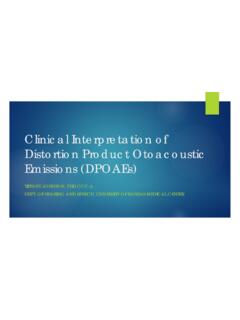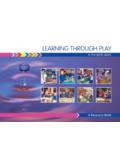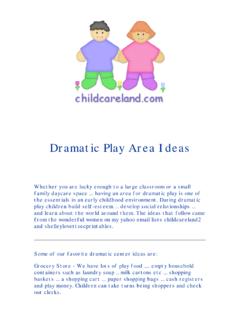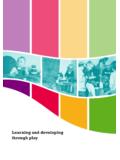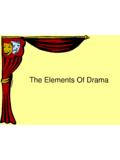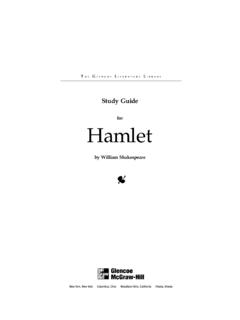Transcription of Disclosures Learning through Play - KSHA
1 9/12/2017 1 Meredith P. Harold, PhD, CCC-SLP for the Kansas Speech Language Hearing Association Conference September 23rd, 2017 Learning through play in Speech Language Therapy Disclosures Assistant Professor at Rockhurst University Owner of The Informed SLP, LLC Regular contributor to and The information shared with you today is the result of a literature review on play -based Learning and instruction for speech and language, performed in 2014 and updated to-date. Clinical examples shared do not come directly from empirical studies but instead are based on the presenter s interpretation and clinical application of available research to-date.
2 play may have a unique ability to enhance Learning and generalization What is play ? Broad definition flexibility and nonliterality positive affect and intrinsic motivation active (rather than passive) engagement no extrinsic goals or Learning that must occur Narrower definitions occasionally include episodic rule-governed process-oriented artifacts other people Dietze & Kashin (2012) Hirsh-Pasek & Golinkoff (2003) Isenberg & Jalongo (2003) Krasnor & Pepler (1980) Miller (2017) Image from Types of play functional play exploration or functional use of objects begins before age 2 construction play blocks, legos, race track games with rules Candy Land, Don t Break the Ice begins around school age outdoor and movement play kick all, hopscotch symbolic, dramatic, and pretend play ( as-if 3) kitchen, zoo, camping begins around age 2 Dietze and Kashin (2012) Garvey (1990) Kostelnik et al.
3 (2011) Watson et al. (2011) 9/12/2017 2 Social stages of play onlooker play watching solitary play playing alone parallel play playing next to, but not with others associative play playing with others (occasional cooperation) cooperative play playing with others (full cooperation; emerges age 4) Kostelnik et al. (2011) Benefits of play plays a role in maturation of problem solving, reasoning, social skills1 improves mood2 improves attention2 plays a role in development of language and narrative skills1, 3 studies consistently find positive benefits of play on Learning outcomes4 and literature suggests that guided play can be used to teach the curriculum 5, 6 et al.
4 2013 et al., 2012 & Almon, 2009 et al., 2013 & Leong (2001) et al. (2006) play & Language Development language (and social) skills associated with symbolic play skills in children ages 1 6 1, 2, 3, 4, 5 for both typically-developing children and those with many disorders, including autism why? unknown, but several theories 1, 9 difficulty accessing both words and ideas? delays or differences in symbolic skills? or just preference for patterned and kinesthetic-type activities? good play skills provide a good context for social language Learning ?
5 (1997) et al. (2000) & Wainwright (2010) & Jones (2011) & Yoder (2001) et al. (2012) (1980) & Goosens (2002) et al. (2011) play in Speech Language Therapy Responsivity Education 1, Prelinguistic Milieu Teaching 2, Milieu Communication Teaching 1,2, programs from The Hanen Centre 3 and many more speech: play -based therapy is beneficial for articulation and phonological therapy, and preferable over drill-only treatment programs 4 language: children learn language best in meaningful and interactive (not passive) contexts 5, 6 social.
6 Positive outcomes found among many studies for play -based Learning and following the child s lead7, 8, 11, 12, 13 for teaching language and social language in children with autism; goals including: joint attention 9, 11, 14 responding to others 10 initiating interactions with others 10 turn taking 10 imitation 11 pretend play 10, 11, 14 et al. (2013) et al. (2006) & Kwiatkowski (1982) et al. (2011) (2002) & Thiemann-Bourque (2012) & Ingersoll (2014) & Stevens (2017) et al. (2016) et al. (2014) & Sainato, 2013 et al, 2012 et al.
7 (2006, 2008) Is play the tool or the goal? Are we teaching play skills to bolster language development, or using play as an instructional strategy, within which we directly teach language? Or Studies consistently find benefits of play for teaching speech language skills, yet the strategy differs from study to What are the commonalities in studies using play to teach speech language skills? So what are SLPs supposed to do? best for teaching the curriculum1 1 Bodrova & Leong (2001), Golinkoff et al. (2006), Hirsh-Pasek & Golinkoff (2004), Weisburg et al.
8 (2013) work playful Learning play playing to learn child-centered therapy guided play whole-child perspective structured communicative play *Fey s Continuum of Naturalness (1986) spans from work to playful Learning adult-directed therapy drill-based free play adult-directed therapy 9/12/2017 3 generalization target density Eisenburg (2004. 2013); Shriberg & Kwiatkowski (1982) So what are SLPs supposed to do? playful Learning involves at least a couple (several?) aspects of play .. we don t know for certain which of these has the biggest impact on Learning ; any/all could contribute to the benefit of playful Learning current best guess from available 1 3 centers around capturing attention, forming memories, and sacrificing as few elements of pure play as possible et al.
9 , 2013 et al., 2008 , 2004 Capturing attention Forming memories 1 2 required targets child must use these in order for play to continue require by considering how to obtain access to a result: social interaction funny/amusing consequence parts of a whole toys suggested targets modeled and used heavily by clinician, but not required of child play -based therapy is NOT unstructured or uncontrolled therapy. Instead, the best execution of playful Learning involves a high level of control by the instructor, imperceptible to the child. *The idea of pre-planning targets for play -based sessions is mentioned throughout our literature, Leonard & Deevy, 2017 Example: speech Example: speech 9/12/2017 4 Consider method, not toy Drill play and other fun work When we need to drill Who is easier to do drill-based activities with?
10 Preschoolers? Early Elementary? Late Elementary? Middle/High School? drill work requires the ability to attend to something that s somewhat boring , and persist The Batman Effect (White et al., 2016) play -Based Tx: Language (2013) (2003) et al. (2016) et al. (2011) generalization vs. target density 1 Because embedded therapies rely largely on consequent instruction ( , intruction delivered after a child had attempted a target form), a possible problem for embedded therapy is the low dose of teaching episodes if a child never or infrequently attempts the target form.



